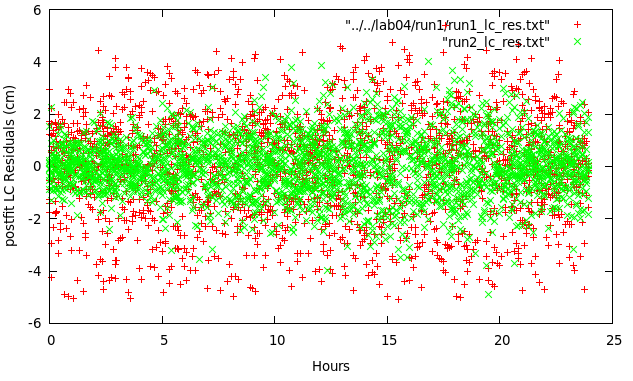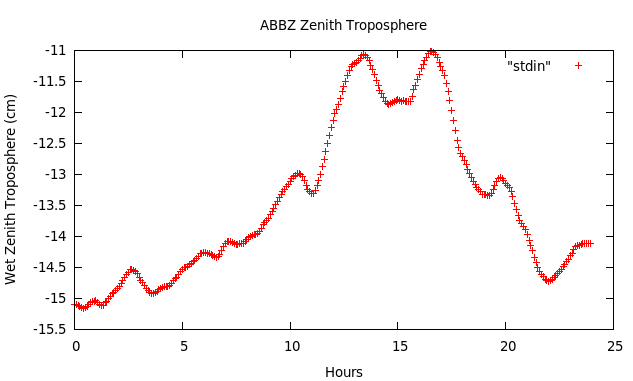New Mexico Tech
Earth and Environmental Science
ERTH 471 / GEOP 572 - Geodetic Methods
Lab 4: gd2p.pl: static position estimation
UNAVCO bumper sticker
Note that you DO have to work on redoubt today!
Introduction
Last week I had you go through the motions of adding a new station
to GIPSY's sta_info database and get used to processing
with gd2p.pl. The processing, however, was quite arbitrary.
I got you to a point where you know how to look at the postfit
residuals. This week we will look a bit more into the various knobs
you can use to improve the processing. You will look at residuals
a lot (last week you figured out how to plot them), which show
you how much the solution improves.
At this point I assume that you have successfully completed lab 4. You may need to go back to its description to lookup some of the details; opening it in a second browser tab is likely a good idea.
To keep myself out of trouble I should note that this lab follows a JPL workshop, but we're using our own data.
Setup
Below I show the sequence of commands that should get us all to the same starting point.
Note that anything between redoubt and > is part of the prompt
and not to be typed. The commands you will use start at the first space and range until the
'#', which I use to comment what that line does.
redoubt:~> cd $GEOP572 #go to working directory redoubt:/data/GEOP572/gps> #'gps' part should be your user name! I am working as user 'gps' redoubt:/data/GEOP572/gps> mkdir lab05 #create folder to work in this week redoubt:/data/GEOP572/gps> cd lab05 #go there redoubt:/data/GEOP572/gps/lab05>setenv WORKDIR `pwd` #creates the variable WORKDIR to refer to this place redoubt:/data/GEOP572/gps/lab05>echo $WORKDIR #print the contents of this variable /data/GEOP/gps/lab05/ #this should be your output I will use this variable below!
Whenever you log out and log back in, make sure to have $WORKDIR set to the value above. Obviously you don't
have to create the lab05 directory every single time, as it will remain there.
If your $WORKDIR contains gps, you're doing it wrong!
Processing: Add Zenith Troposphere
Make a new directory for this run:
$> mkdir $WORKDIR/run2 $> cd $WORKDIR/run2
From last week's lab, copy the run_again script into $WORKDIR/run2. I assume
that you worked in $GEOP572/lab04/run1:
$> cp $GEOP572/lab04/run1/run_again ./r2
$> cat r2 #should give you the output below (minus the 'gps' subdir)
#!/bin/csh -f
#The following environment variables were active:
#setenv GOA /usr/local/GIPSY/goa-6.3
#You may need the following source command to set your PATH if you have changed it
#source /usr/local/GIPSY/goa-6.3/rc_gipsy.csh
( gd2p.pl \
-i /data/GEOP572/gps/lab04/abbz2000.15o \
-n ABBZ \
-d 2015-07-19 \
-r 300 \
-type s \
-w_elmin 15 \
-e "-a 20 -PC -LC -F" \
-pb_min_slip 1.0e-3 \
-pb_min_elev 30 \
-amb_res 2 \
-dwght 1.0e-5 1.0e-3 \
-post_wind 5.0e-3 5.0e-5 \
-trop_z_rw -1.0 \
-tides \
-orb_clk "flinnR /data/GEOP572/gps/lab04/orbit" \
-sta_info /data/GEOP572/gps/sta_info \
> gd2p.log ) |& sed '/^Skipping namelist/d' > gd2p.err
No surprises here! Exactly what you've done last week. Note that the stdout and stderr log files
now are gd2p.log and gd2p.err, while they used to be
run1.log and run1.er. That's alright. No need to change things. As we will
be keeping our results in separate directories, there is no danger of overwriting results / logs.
Let's get to the wet troposphere. The current -1.0 is a negative value for parameter -trop_z_rw. If you
read the documentation, you know that a negative value for this parameter means that
it won't be estimated. That's purely instructional. Change this value
to 5.0e-8 km/sqrt(sec) - this is a random walk value that is recommended from (JPL's) experience.
Save and execute the script:
$> ./r2
If you list your directory contents, you the file EDIT_POINT_FAILURE didn't show up. gd2p.err should
contain only warnings, no serious errors - the edit cycle converged! Yay! If you now compare the postfit
residuals (LC) you will find them to be much smaller and the outliers are gone:
redoubt:/data/GEOP572/gps/lab05/run2> cat ../../lab04/run1/Postfit.sum #OLD RUN1
start time stop time type user postfit sigma npts outliers
15JUL18 23:59:43 15JUL19 23:54:43 LC ABBZ 1.9478E-05 2073 434
15JUL18 23:59:43 15JUL19 23:54:43 PC ABBZ 4.4347E-04 2507 0
redoubt:/data/GEOP572/gps/lab05/run2> cat Postfit.sum #RUN 2
start time stop time type user postfit sigma npts outliers
15JUL18 23:59:43 15JUL19 23:54:43 LC ABBZ 1.1021E-05 2507 0
15JUL18 23:59:43 15JUL19 23:54:43 PC ABBZ 4.4397E-04 2507 0
Let's look at the residuals. I provide a script that creates the 2 file for lc and pc
residuals that can be used for the plotting geop572_make_residuals.sh
redoubt:/data/GEOP572/gps/lab05/run2> geop572_make_residuals.sh
Removing pre-existing output file residuals.txt
created: run2_lc_res.txt run2_pc_res.txt
Now you can make the plots that compare previous and current residuals (we'll do that a lot):
$> gnup -p ../../lab04/run1/run1_lc_res.txt run2_lc_res.txt -xl 'Hours' -yl 'postfit LC residuals (cm)'
You should get something like this:

Clearly, the phase residuals are overall smaller, so we must have some wet troposphere. Plot it with the script plot_wetz.sh
that I provide (you need to provide the site ID as argument):
$> plot_wetz.sh ABBZ
You should get something like this:

Clearly, some variation, with the values most from 0 at the beginning and end of the day.
The file tdp_* files contain information about the estimated parameters. The
file tdp_final contains the final estimates:
- receiver clock is in field STA BIAS (km)
- phase biases per satellite PB GPSXX (km)
- station position STA X, STA Y, STA Z (km)
- dummy parameter used by
filterDUM - Now zenith troposphere estimates WETZTROP
$> awk '{print $5,$6}' tdp_final | sort -u
If you were to look into the tdp file, you'll find a lot more. The meaning of the fields is documented here:
$> less $GOA/file_formats/tdp
To get the position estimate you can use:
$> grep "STA [XYZ]" tdp_final
Use xyz2wgs.py to convert the values into WGS84 positions. Note that you need to convert from
kilometers to meters!
Adding Ocean and Earth Tides,
Make a new directory for this run and copy the r2 runscript:
$> mkdir $WORKDIR/run3
$> cd $WORKDIR/run3
$> cp $WORKDIR/run2/r2 ./r3
Now for the parameters. Change the tides line to:
-tides WahrK1 FreqDepLove OctTid PolTid \
WahrK1, FreqDepLove, OctTid invoke complete solid Earth tide models from IERS standards, PolTid invokes solid Earth pole tide from IERS standards.
Produce a plot of the LC residuals of run3 compared to run1. Quite impressive, huh?
While we're at it, add an ocean load tide model (into r3, no need for a new directory if you've created the
plot above!). Add the following lines into r3
-add_ocnld \
-OcnldCpn \
-add_ocnldpoltid\
add_ocnldadds 11 tidal frequencies: M2, S2, K2, N2, K1, O1, P1, Q1, Mf, Mm, Ssa.- Default uses
$GOA_VAR/sta_info/ocnld_coeff_cm_got48ac_wtpxo8ofunc - can compute and add your own:
-add_ocnld " -c your_coefficient_file" - must be with respect to center of mass of earth system (solid earth and oceans)!
OcnldCpninfers other tidal frequencies from 11 given onesadd_ocnldpoltidadds Ocean load pole tide model - small improvement (12 and 14 month period)
Produce a plot of the LC residuals of run3 compared to run2. A lot of the residuals in second half of day were due to tides!
Seems like it ran? Seems like you produced a new plot? Check gd2p.err! What's the error you are getting?
I have an oceanload model for the site ABBZ at $GIPSY/ocnload/tpxo72atlas_CM/gipsy/ABBZ.ocnld - add this
to r3 as described above and rerun! (Note that the space is actually important!)
Produce a plot of the LC residuals of run3 compared to run2. A lot of the residuals in second half of day was due to tides!
Now we can add troposphere gradients (wetzgrad with recommended values), change the troposphere mapping function to something more modern (GPT2), and second order Ionosphere correction, as well as elevation dependent weighting using the sqrt(sin) of the elevation angle weight function.
-wetzgrad 5.0e-9\
-trop_map GPT2\
-ion_2nd\
-shell_height 600\
-tec_mdl iri\
-eldepwght SQRTSIN\
Produce a plot of the LC residuals of run3 compared to run1. A lot of the residuals in second half of day was due to tides!
At this point we still have some work to do with respect to the antenna. This will happen next week.
What are the differences between nominal position and final solution for each run: run1 (last week), run2, run3 (subtract respective columns in tdp_final for the respective run). Give a table:
| run 1 | run 2 | run 2
--------+===========================
delta X |
delta Y |
delta Z |
Deliverables: (submit via canvas!)
- ABBZ position after troposphere correction
- Plot of the LC residuals with Earth tides removed (run3 vs run1)
- Plot of the LC residuals with Earth tides, ocean tides removed (run3 vs run2) - the fixed version!
- Table of position changes
- Final script
r3
rg <at> nmt <dot> edu | Last modified: September 16 2015 20:17.